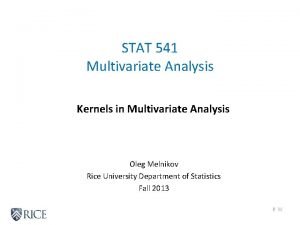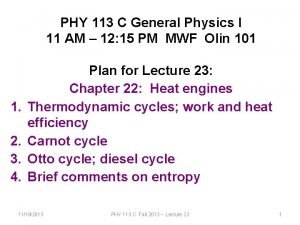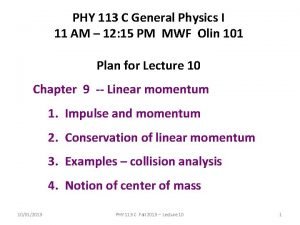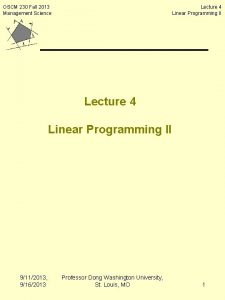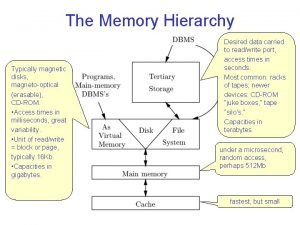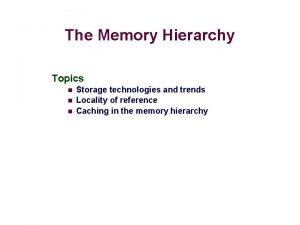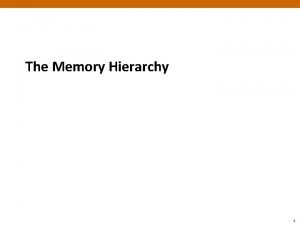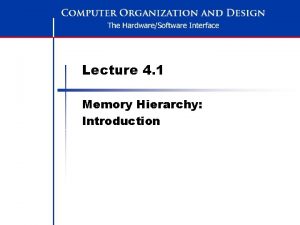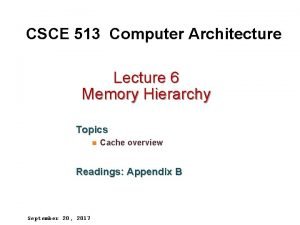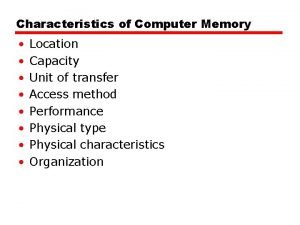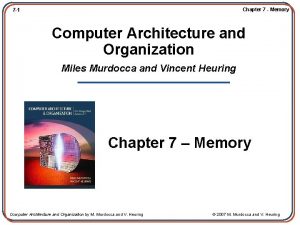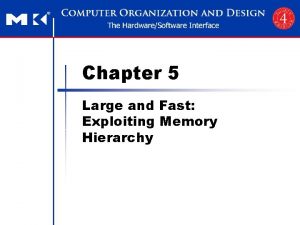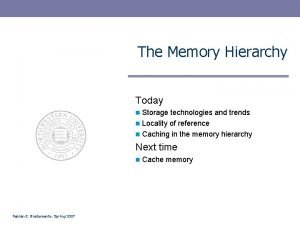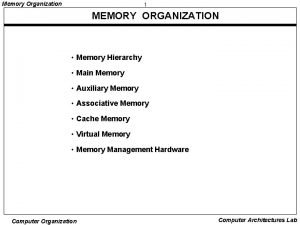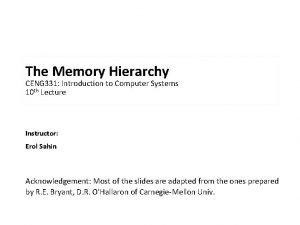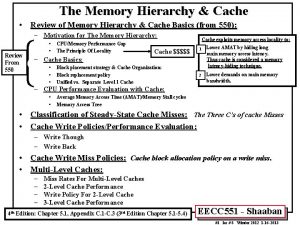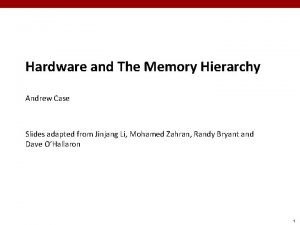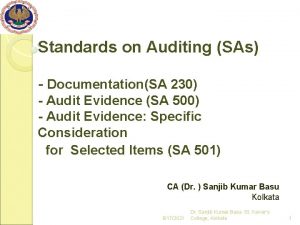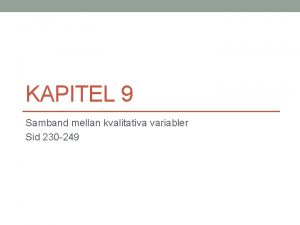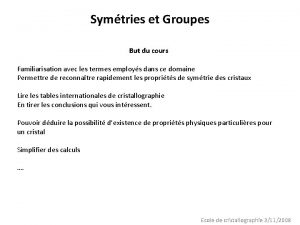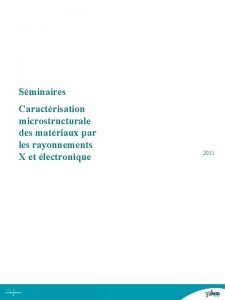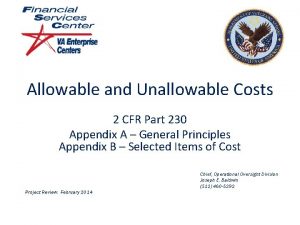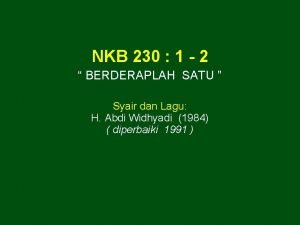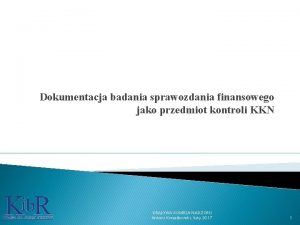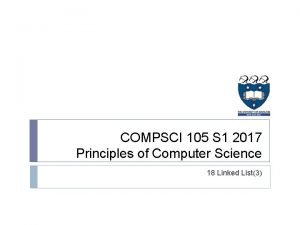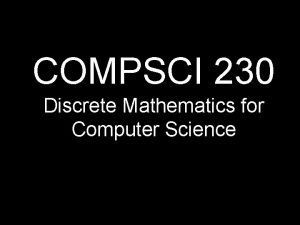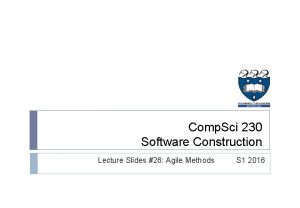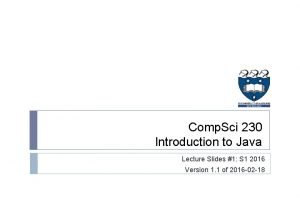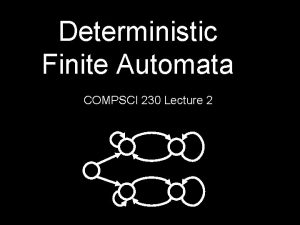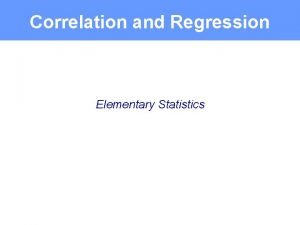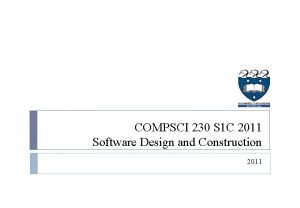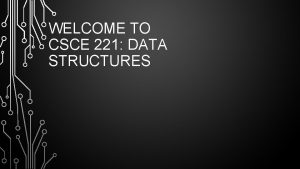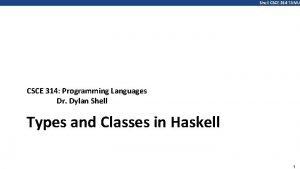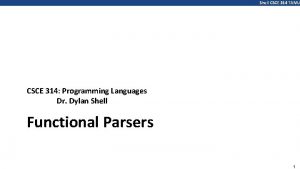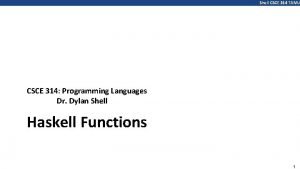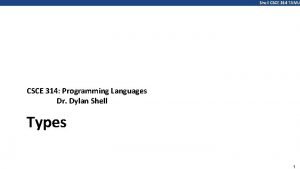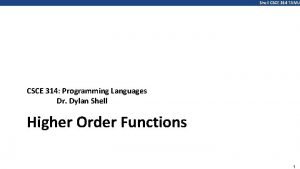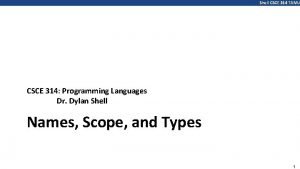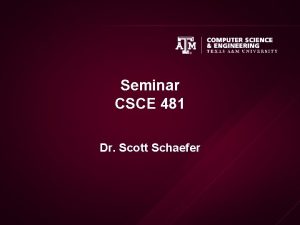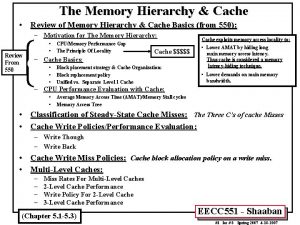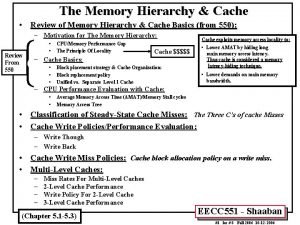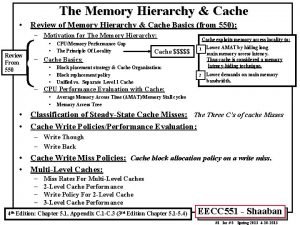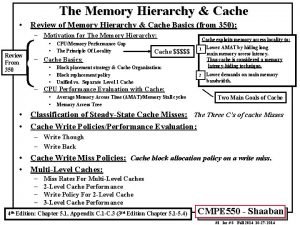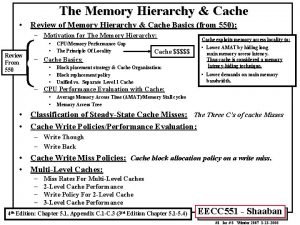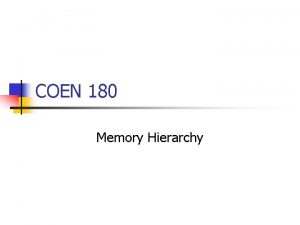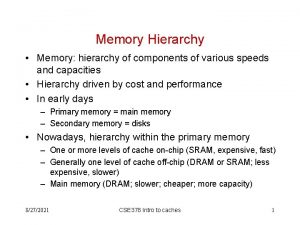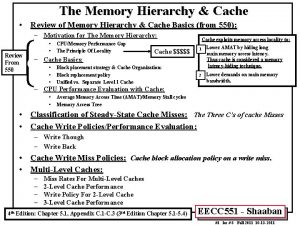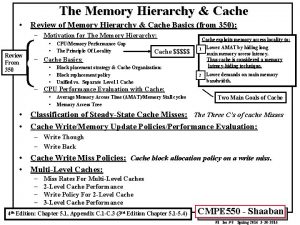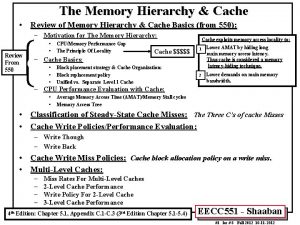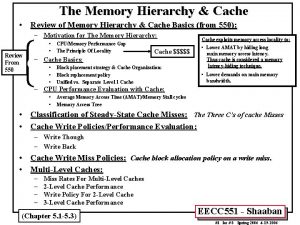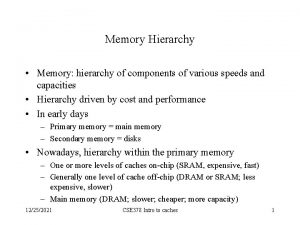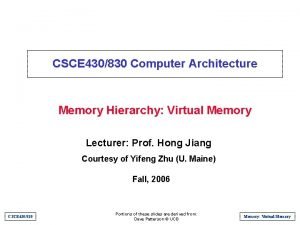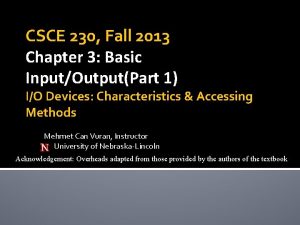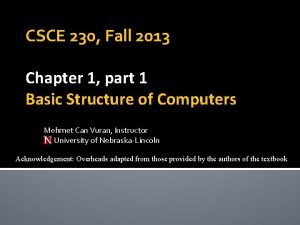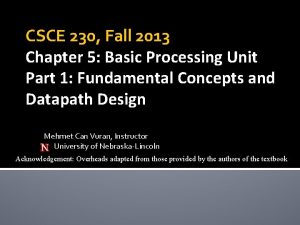CSCE 230 Fall 2013 Chapter 8 Memory Hierarchy





































































- Slides: 69

CSCE 230, Fall 2013 Chapter 8 Memory Hierarchy Mehmet Can Vuran, Instructor University of Nebraska-Lincoln Acknowledgement: Overheads adapted from those provided by the authors of the textbook

* Genesis � Increasing gap between processor and main memory speeds since the 1980 s, became the cause of primary bottleneck in overall system performance. in the decade of 1990 s, processor clock rates increased at 40%/year, while main memory (DRAM) speeds went up by only 11%/year. � Building small fast cache memories emerged as a solution. Effectiveness illustrated by experimental studies: 1. 6 x improvement in the performance of VAX 11/780 (c. 1970 s) vs. 15 x improvement in performance of HP 9000/735 (c. early 1990 s) [Jouppi, ISCA 1990] • See Trace-Driven Memory Simulation: A Survey, Computing Surveys, June 1997. • See, also, IBM’s Cognitive Computing initiative for an alternative way of organizing computation. . 2

CPU + memory Abstraction address memory data 200 PC CPU 200 ADD a, b, c ADD IRa, b, c 3

In reality… Processor Level-1 Cache Level-2 Cache Level-3 Cache Main Memory Storage 4

In reality… L 1 Instruction Cache: 32. 0 KB, L 1 Data Cache: 32. 0 KB 5

Cache Operation cache controller address CPU dat a Cache hit data cache address main memory data Cache miss 6

Quick Review: Memory Hierarchy �Memory Hierarchy: Registers, Caches, Main, Disk (upper to lower) �Upper levels faster, costlier �Lower levels larger in capacity �Design Goal: Strive for access time of the highest level for the capacity available at the lowest level �Made possible because of locality of instruction and data references to memory 7

Memory Hierarchy �Processor registers are fastest, but do not use the same address space as the memory �Cache memory often consists of 2 (or 3) levels, and technology enables on-chip integration �Holds copies of program instructions and data stored in the large external main memory �For very large programs, or multiple programs active at the same time, need more storage �Use disks to hold what exceeds main memory 8

Memory Hierarchy with One-Level Cache PROCESSOR CACHE Access Time: 1 unit Capacity: O(10 KB) MAIN MEMORY Access Time: 100 units Capacity: O(GB) MAGNETIC DISK Access Time: 107 units Capacity: O(100 GB) 9

Caches and Locality of Reference �The cache is between processor and memory �Makes large, slow main memory appear fast �Effectiveness is based on locality of reference �Typical program behavior involves executing instructions in loops and accessing array data �Temporal locality: instructions/data that have been recently accessed are likely to be again �Spatial locality: nearby instructions or data are likely to be accessed after current access 10

More Cache Concepts �To exploit spatial locality, transfer cache block with multiple adjacent words from memory �Later accesses to nearby words are fast, provided that cache still contains the block �Mapping function determines where a block from memory is to be located in the cache �When cache is full, replacement algorithm determines which block to remove for space 11

Cache Operation �Processor issues Read and Write requests as if it were accessing main memory directly �But control circuitry first checks the cache �If desired information is present in the cache, a read or write hit occurs �For a read hit, main memory is not involved; the cache provides the desired information �For a write hit, there are two approaches 12

Handling Cache Writes �Write-through protocol: update cache & mem. �Write-back protocol: only updates the cache; memory updated later when block is replaced �Write-back scheme needs modified or dirty bit to mark blocks that are updated in the cache �If same location is written repeatedly, then write-back is much better than write-through �Single memory update is often more efficient, even if writing back unchanged words 13

Handling Cache Misses �If desired information is not present in cache, a read or write miss occurs �For a read miss, the block with desired word is transferred from main memory to the cache �For a write miss under write-through protocol, information is written to the main memory �Under write-back protocol, first transfer block containing the addressed word into the cache �Then overwrite location in cached block 14

Mapping Functions �Block of consecutive words in main memory must be transferred to the cache after a miss �The mapping function determines the location �Study three different mapping functions �Use small cache with 128 blocks of 16 words Block size: 16 words Cache size: 128 x 16 = 2048 words �Use main memory with 64 K words (4 K blocks) Number of blocks = 64 K/16 = 4 K �Word-addressable memory, so 16 -bit address 2^16 = 64 K 15

Mapping Functions �Study three different mapping functions Direct Mapping Associative Mapping Set-associative Mapping 16

Direct Mapping �Simplest approach uses a fixed mapping: memory block j cache block ( j mod 128 ) �Only one unique location for each mem. block �Two blocks may contend for same location �New block always overwrites previous block �Divide address into 3 fields: word, block, tag �Block field determines location in cache �Tag field from original address stored in cache �Compared with later address for hit or miss 17

18

Example Word# 0 15 0 0. . . Cache Block# 1 1 VD 5 bits TAG 16 x 32 bits D A T A 127 One Block Wide Block# 15 Memory Address 0 4 3 Word# Block# Cache Block # = Block # mod 128 Cache Address 0 4 3 Cache Block# Word# 10 4 K-1 One Block Wide 19

Resulting Partitioning of Memory Address and Address Mapping Memory Address = <Tag, Cache Block #, Word #> where, Tag is 5 bits – range is 0 -31 Cache Block # is 7 bits – range is 0 -127 Word # is 4 bits – range is 0 -15 Example: Memory address <27, 87, 11> will map to Cache Block # 87 and will have a tag value of 27. The addressed word will be Word # 11 in this block. 20

Associative Mapping �Full flexibility: locate block anywhere in cache �Block field of address no longer needs any bits �Tag field is enlarged to encompass those bits �Larger tag stored in cache with each block �For hit/miss, compare all tags simultaneously in parallel against tag field of given address �This associative search increases complexity �Flexible mapping also requires appropriate replacement algorithm when cache is full 21

22

Set-Associative Mapping �Combination of direct & associative mapping �Group blocks of cache into sets �Block field bits map a block to a unique set �But any block within a set may be used �Associative search involves only tags in a set �Replacement algorithm is only for blocks in set �Reducing flexibility also reduces complexity �k blocks/set k-way set-associative cache �Direct-mapped 1 -way; associative all-way 23

2 -way set-associative 24

Stale Data �Each block has a valid bit, initialized to 0 �No hit if valid bit is 0, even if tag match occurs �Valid bit set to 1 when a block placed in cache �Consider direct memory access, where data is transferred from disk to the memory �Cache may contain stale data from memory, so valid bits are cleared to 0 for those blocks �Memory disk transfers: avoid stale data by flushing modified blocks from cache to mem. 25

LRU Replacement Algorithm The following algorithm implements the FIFO based LRU algorithm by associating and updating the FIFO position of each element in a k–way set dynamically, as new elements are brought in the set or old ones replaced. � For k-way set associativity, each block in a set has a counter ranging from 0 to k 1 � On hit: Set counter of hit block as 0; increment others with counters lower than original counter value of the hit block � On miss and the set is not full: Set counter of incoming block as 0 and increment all other block counters by 1 � On miss and the set full: Replace the block with Counter=k-1, set counter of incoming block as 0 and increment all other block counters by 1 26

LRU Algorithm in terms of FIFO � FIFO size = number of ways (4 for 4 -way set associative) � FIFO positions numbered 0 (for MRU) to 3 (for LRU) � Insertions and promotions at the MRU position � Eviction at the LRU position. � For access to a new block (miss): Evict block at LRU position (if no room) Insert the new block at the MRU position (other blocks move one position) � For access to an existing block (hit) Promote it to the MRU position (other blocks that were ahead in FIFO move one position) Needs log 2 A bits/block, where A=#ways. Can use smaller FIFO (fewer bits) with reduced accuracy. 27

LRU Algorithm in terms of FIFO Example 0 1 2 3 – – 55 17 25 – 30 22 25 55 0 1 2 3 17 – – – 25 55 17 – 29 30 22 25 55 evicted 0 1 2 3 25 17 – – 30 25 55 17 0 1 2 3 17 25 – – 22 30 25 55 17 evicted Reference Sequence: 17, 25, 17, 55, 25, 30, 22, 30 29 28

Example 29

Cache Performance � Primary Measure: Average Access Time Can compute for each level of cache in terms of its hit rate (h), cache access time (C) and miss penalty (M): Then, can combine successive levels, say L 1 and L 2, by noting that the average miss penalty of L 1 is the same as the average access time of L 2. Hence, assuming unified L 1 cache for instructions and data (not the common case). If $L 1 D and $L 1 I are separate, use weighted average. 36

Example 8. 4 � Given: Cache with two levels: L 1 and L 2 Performance data: ▪ L 1: access time: T, hit rate: 0. 96 ▪ L 2: access time: 15 T, hit rate: 0. 8 ▪ Transfer times: L 2 to L 1: 15 T, M to L 2: 100 T a) b) c) d) What fraction of accesses miss both L 1 and L 2? What is the av. access time seen by processor? By what factor would it reduce If L 2’s hit rate were perfect, i. e. 1. 0? What is the av. access time seen by processor if L 2 is removed and L 1 is increased so as to halve its miss rate? Note: Answers to (b) – (d) depend on assumptions made about the miss penalty. 37

Solution a) b) 20% of 4% =. 2*. 04 =. 008 AMATproc = h 1*HTL 1 + (1 -h 1)MPL 1 = h 2*HTL 2 + (1 -h 2)MPL 2 = HTMain Assume: Whenever the data is transferred from one level of the memory hierarchy to the next lower level, it is also made available to the processor at the same time (assumes additional data paths). Hence: AMATproc = h 1*HTL 1 + (1 -h 1)[h 2*HTL 2 + (1 -h 2) HTMain] = 0. 96*T + 0. 04(0. 8*15 T + 0. 2*100 T) = 2. 24 T Parts (c) and (d) can be answered in a similar way. 38

Performance Enhancement Methods � Use Write Buffer when using write-through. Obviates the need to wait for the write-through to complete, e. g. the processor can continue as soon as the buffer write is complete. (see further details in the textbook) Prefetch data into cache before they are needed. Can be done in software (by user or compiler) by inserting special prefetch instructions. Hardware solutions also possible and can take advantage of dynamic access patterns. � Lockup-Free Cache: Redesigned cache that can serve multiple outstanding misses. Helps with the use of software-implemented prefetching. � Interleaved main memory. Instead of storing successive words in a block in the same memory module, store it in independently accessible modules – a form of parallelism. Latency of first word still the same but the successive words can be transferred much faster. � 39

Address Translation with Caches 40

Virtual Memory (Why? ) �Physical mem. capacity address space size �A large program or many active programs may not be entirely resident in the main memory �Use secondary storage (e. g. , magnetic disk) to hold portions exceeding memory capacity �Needed portions are automatically loaded into the memory, replacing other portions �Programmers need not be aware of actions; virtual memory hides capacity limitations 41

Virtual Memory (What? ) �Programs written assuming full address space �Processor issues virtual or logical address �Must be translated into physical address �Proceed with normal memory operation when addressed contents are in the memory �When no current physical address exists, perform actions to place contents in memory �System may select any physical address; no unique assignment for a virtual address 42

Memory Management Unit �Implementation of virtual memory relies on a memory management unit (MMU) �Maintains virtual physical address mapping to perform the necessary translation �When no current physical address exists, MMU invokes operating system services �Causes transfer of desired contents from disk to the main memory using DMA scheme �MMU mapping information is also updated 43

The Big Picture: Full Memory Hierarchy Disk address 44

Address Translation �Use fixed-length unit of pages (2 K-16 K bytes) �Larger size than cache blocks due to slow disks �For translation, divide address bits into 2 fields �Lower bits give offset of word within page �Upper bits give virtual page number (VPN) �Translation preserves offset bits, but causes VPN bits to be replaced with page frame bits �Page table (stored in the main memory) provides information to perform translation 45

Page Table �MMU must know location of page table �Page table base register has starting address �Adding VPN to base register contents gives location of corresponding entry about page �If page is in memory, table gives frame bits �Otherwise, table may indicate disk location �Control bits for each entry include a valid bit and modified bit indicating needed copy-back �Also have bits for page read/write permissions 46

Virtual-to-Physical Address Translation Using Page Tables 47

Translation Lookaside Buffer �MMU must perform lookup in page table for translation of every virtual address �For large physical memory, MMU cannot hold entire page table with all of its information �Translation lookaside buffer (TLB) in the MMU holds recently-accessed entries of page table �Associative searches are performed on the TLB with virtual addresses to find matching entries �If miss in TLB, access full table and update TLB 48

TLB Operation 49

Page Faults �A page fault occurs when a virtual address has no corresponding physical address �MMU raises an interrupt for operating system to place the containing page in the memory �Operating system selects location using LRU, performing copy-back if needed for old page �Delay may be long, involving disk accesses, hence another program is selected to execute �Suspended program restarts later when ready 50

Memory Organization: Basic Concepts �Access provided by processor-memory interface �Address and data lines, and also control lines for command (Read/Write), timing, data size �Memory access time is time from initiation to completion of a word or byte transfer �Memory cycle time is minimum time delay between initiation of successive transfers �Random-access memory (RAM) means that access time is same, independent of location 55

56

Semiconductor RAM Memories �Memory chips have a common organization �Cells holding single bits arranged in an array �Words are rows; cells connected to word lines (cells per row bits per processor word) �Cells in columns connect to bit lines �Sense/Write circuits are interfaces between internal bit lines and data I/O pins of chip �Common control pin connections include Read/Write command chip select (CS) 57

Memory Chips: Internal Organization �Depends on if address decoding is 1 -D or 2 -D Fig. 8. 2 shows example of 1 -D decoding Fig. 8. 3 shows example of 2 -D decoding 58

Fig. 8. 2 59

Fig. 8. 3 60

An Example Block Diagram of a Commercial Chip 64 Kx 16 High-Speed CMOS Static RAM 61

Another Example of a Commercial Chip 128 Kx 8 Low-Voltage Ultra Low Power Static RAM 62

Building Larger Memories from Chips Assume a 32 x 1 chip: 5 chips 128 x 4 memory using 16 chips Address CE � Consider building: 32 x 4 memory using 4 chips 128 x 1 memory using 4 Data VDD GND 63

32 x 4 A 4 -0 1 1 VDD 4 GND Data 1 1 64

128 x 1 A 4 -0 3 VDD GND A 6 -5 Decoder 2 Data 1 0 65

128 x 4: Exercise (See Fig. 8. 10 for a larger example of a static memory system) 66

Dynamic RAM Chips �Consider 32 M 8 chip with 16 K 2 K array � 16, 384 cells per row organized as 2048 bytes � 14 bits to select row, 11 bits for byte in row �Use multiplexing of row/column on same pins �Row/column address latches capture bits �Row/column address strobe signals for timing (asserted low with row/column address bits) �Asynchronous DRAMs: delay-based access, external controller refreshes rows periodically 67

68

Read on your own: �Fast Page Mode �SRAM, DRAM, SDRAM �Double Data-Rate (DDR) SDRAMs �Dynamic Memory Systems �Memory Controller �ROM, PROM, EPROM, and Flash 69

Concluding Remarks �Memory hierarchy is an important concept �Considers speed/capacity/cost issues and also reflects awareness of locality of reference �Leads to caches and virtual memory �Semiconductor memory chips have a common internal organization, differing in cell design �Importance of block transfers for efficiency �Magnetic & optical disks for secondary storage 70

Summary of Cache Memory

Basic Concepts �Motivation: Growing gap between processor and memory speeds (Memory Wall) �Smaller the memory faster it is, hence memory hierarchy is created: L 1, L 2, L 3, Main, Disk. Access caches before main Access lower level cache before upper level �Reason it works: Temporal and spatial locality of accessed in program execution �An access can be read or write, either can result in a hit or a miss.

Handling Reads � Hits are easy: Just access the item � Read miss requires accessing higher level to retrieve the block that contains the item to be accessed. Require placement and replacement schemes � Placement: Where to place the block in cache (mapping function) � Replacement: kicks in only if (a) there is a choice in placement and (b) if the incoming block would overwrite an already placed block. � Recency of access used as the criterion for replacement – requires extra bits to keep track of dynamic accesses to the block.

Writes �Two design options: write-through and write- back. �Write hit: means block already in cache so write the field within it. Also write to higher levels for write-through, Otherwise, set the dirty for write-back �Write miss: Just write the upper level and not the cache for write through Otherwise, read the block first and then write

Address Translation with Caches 76

Address Mapping �Goal: Given a physical main-memory bloc address, determine where to access it in the cache. �Elaboration: 1. The mapping has to be many-to-one: multiple main memory blocks mapped to a cache block. 2. All commonly used mapping schemes can be thought of as mapping the address to a set in the cache, where the set can hold k blocks for a k-way set associative cache. In case of a miss, the incoming block can be placed in any of the k blocks, the actual choice being determined by the replacement policy. 77

Example: 16 -bit physical address, byte addressability, block-size = 16 bytes; cache size = 128 blocks. 15 4 3 m Tag 0 Block Offset Set # 1 -way set associative Fully set associative 4 -way set associative 8 -way set associative (128 -ways) (Direct Mapped) #Blocks/set: 1 128 4 8 #Sets: 128 1 32 16 m-4+1: 7 0 5 4 #Tag-bits: 5 12 7 8 78

Define a cache line: V D U Tag Data Block Direct Mapped 4 -ways 1 Cache Line Set 0 0 Set 1 1 . . . . 31 Set 127 79

Fully set-associative 128 -ways 1 Cache Line Set 0 . . . 128 Cache Lines 80
 Section 230-240 of companies act 2013
Section 230-240 of companies act 2013 Virtual memory in memory hierarchy consists of
Virtual memory in memory hierarchy consists of Fall 2013
Fall 2013 Fall 2013
Fall 2013 Fall 2013
Fall 2013 Fall 2013
Fall 2013 Fall protection basics
Fall protection basics Magnetic disk in memory hierarchy
Magnetic disk in memory hierarchy Draw memory hierarchy
Draw memory hierarchy Memory hierarchy
Memory hierarchy Memory hierarchy in os
Memory hierarchy in os Explain memory hierarchy
Explain memory hierarchy Memory hierarchy in computer architecture
Memory hierarchy in computer architecture Computer memory hierarchy
Computer memory hierarchy Computer memory hierarchy diagram
Computer memory hierarchy diagram Memory hierarchy definition
Memory hierarchy definition Computer memory hierarchy diagram
Computer memory hierarchy diagram Memory hierarchy in coa
Memory hierarchy in coa Large and fast: exploiting memory hierarchy
Large and fast: exploiting memory hierarchy Hierarchy of trends
Hierarchy of trends What is memory organization
What is memory organization Memory hierarchy
Memory hierarchy Draw memory hierarchy diagram
Draw memory hierarchy diagram Memory hierarchy
Memory hierarchy Tlb computer architecture
Tlb computer architecture Memory hierarchy
Memory hierarchy Sa 230
Sa 230 Sid 230
Sid 230 300'e yuvarlanan en büyük sayı
300'e yuvarlanan en büyük sayı Reglamento loei
Reglamento loei S-230 crew boss quizlet
S-230 crew boss quizlet 230 groupes d'espace
230 groupes d'espace Représentation des 230 groupes d'espace
Représentation des 230 groupes d'espace Isa 230 documentation retention period
Isa 230 documentation retention period Quest king of prussia
Quest king of prussia Cfr 230
Cfr 230 Zodiac cadet aero 270
Zodiac cadet aero 270 Nkb 230
Nkb 230 Msb 230
Msb 230 Duke cs 230
Duke cs 230 Nyatakan 230 derajat dalam ukuran radian
Nyatakan 230 derajat dalam ukuran radian Edu 230
Edu 230 Dermatology case presentation
Dermatology case presentation Hhhhhhht
Hhhhhhht Sci 230
Sci 230 Compsci 230 review
Compsci 230 review Os 230
Os 230 Vodafone infodok 230
Vodafone infodok 230 Mizzou identity standards
Mizzou identity standards Compsci 230 duke
Compsci 230 duke Statistics and correlation
Statistics and correlation Compsci 230
Compsci 230 Semantic memory
Semantic memory Implicit memory vs explicit memory
Implicit memory vs explicit memory Long term memory vs short term memory
Long term memory vs short term memory Internal memory and external memory
Internal memory and external memory Primary memory and secondary memory
Primary memory and secondary memory Logical address
Logical address Which memory is the actual working memory?
Which memory is the actual working memory? Virtual memory
Virtual memory Eidetic memory vs iconic memory
Eidetic memory vs iconic memory Shared vs distributed memory
Shared vs distributed memory Csce 221 tamu
Csce 221 tamu Csce 314
Csce 314 Csce 314
Csce 314 Csce 314
Csce 314 Csce 314 tamu
Csce 314 tamu Csce 314
Csce 314 Csce 314 tamu
Csce 314 tamu Scott schaefer tamu
Scott schaefer tamu


